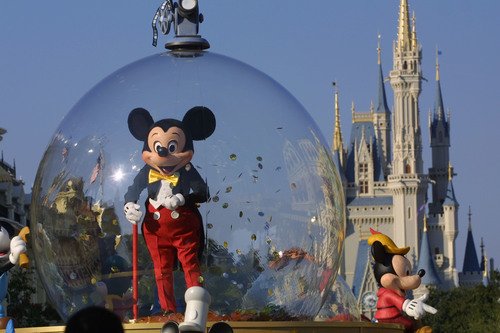Planning a trip to Disney World? How to get to Orlando this summer

Disney World theme parks’ plans to begin a phased reopening starting July 11 include an extensive list of changes, rules and Covid-era protocols for the safety and well-being of guests and staff alike.
What the park’s reopening plan does not contain is information on the best ways to get there.
But, if the Florida park’s reopening goes as planned — Disneyland in California set a reopening date and postponed it after seeing a spike in cases, suggesting a Disney World postponement is not out of the question — we’ve compiled some basic how-to-get-there information.
There is no one-size-fits-all when it comes to travel to Orlando, which is as easy as a few hours in the car for some families and as complicated as a multileg flight or bus journey for others.
Although Orlando International Airport (MCO) operates four terminals containing 129 gates, the central Florida city sees more visitors driving in, not flying. And this was true before Covid-19.
George Aguel, president and CEO of Visit Orlando, explains that “over 91% of our visitor base comes from the US, and of that, over 70% of our visitors drive versus fly. We know that as travel begins to resume, people will feel most comfortable venturing closer to home, and we are well-poised for that trend.”
Although Aguel says most of Orlando’s drive-in visitation is from within the state, he notes that “in addition to the Southeast, you may be surprised to know that some of our top drive markets include the Northeast and mid-Atlantic.”
While the Visit Orlando CEO cannot provide visitation numbers for the parks or shed light on what percentage of people visiting Orlando do so solely to visit the Disney parks, he does say “experiencing our world-famous parks is a top priority for many visitors.”
Orlando is, after all, the Theme Park Capital of the World®.
Trains, buses and planes
Self-driving is the most popular choice according to Aguel, but all is not lost if you don’t have a car and aren’t interested in renting one.
Sanford, about 28 miles from Orlando, has an Amtrak station.
The Amtrak website is currently advertising the Auto Train: The 17 hour and 29 minute ride goes from Lorton, Virginia, outside of Washington, all the way to Sanford, close to Orlando. But this is no ordinary passenger train, as referenced by its name.
The Auto Train transports passengers and their vehicle (be it car, van, motorcycle, SUV, small boat or Jet Ski) nonstop from Virginia to Florida. It’s billed as “the best way to drive I-95 without even driving.”
The Auto Train starts at $89 per person with rates for vehicles available upon request (that is, if you can find your way around Amtrak’s virtual travel assistant).
Other Amtrak options are available based on US location (and there are stations in Orlando and Kissimmee), but check the website for the latest on operating routes as Covid-19 has impacted service.
Several bus lines operate service in and out of Orlando. From Atlanta, it’s a nine-hour ride via Megabus that can be purchased for as little as $49.99 one way — if you don’t mind an overnight service.
From Chicago down to sunny Florida, it’s a longer bus ride, but Greyhound will get you there for $125 one way. The trip involves two transfers and takes over a day.
Aguel says only a small portion of Orlando’s visitors — about 3% — arrive by train or bus.
While MCO’s Covid warning includes a note on international flights being affected by travel restrictions, domestic airline travelers will likely have an easier time arriving in Orlando by air.
From New York City, for example, Delta is offering several daily nonstop flights and more with connections. American Airlines also has both nonstop and connecting flight available from the New York area.
United Airlines has nonstop flights from Denver; Spirit and Southwest are two other carriers operating flights into the Orlando area.
Of course, traveling by any other means besides your own vehicle comes with its own set of Covid-19-related risks.
If you drive, you’ll be in a self-contained environment that you control, except when you factor in stops for gas, food and restroom breaks.
Even with restroom and fast food drive-thru stops though, “you can control your environment regarding the interaction with other people to a much greater extent than you can traveling on an airliner. And of course whatever time you spend on the plane, you’re in a very enclosed environment with other people, all of whom may not be wearing masks,” explains Dr. William Schaffner, an infectious diseases specialist at Vanderbilt Medical Center in Nashville, Tennessee.
Flying, on the other hand, means exposure to others in a confined environment, for as long as your flight is. Same goes for the train or bus.
Wearing a mask and practicing social distancing in as much as possible is advised.
Getting to the parks
Once you’ve arrived in Orlando, if not in your own vehicle, there are more logistical considerations.
You may need to take an Uber or taxi cab from the airport, Amtrak station or bus depot.
This is again when travelers will need to weigh the external risks, a key piece in the decision-making process of travel at this time, according to Schaffner, who says: “The virus likes to be transmitted through close personal contact in enclosed spaces.”
Driving your own vehicle and parking it as close as possible to the park(s) you plan on visiting is the most controlled environment.
Staying at a resort in walking distance of the park is another option that eliminates time on crowded monorails and shuttles where social distancing is likely to be challenging.




